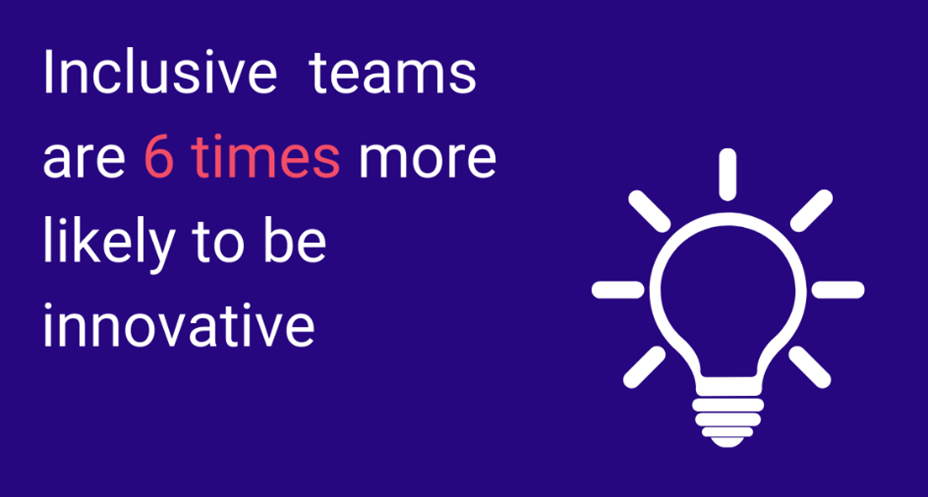To innovate, companies need new ideas and creative thinking to generate new products, services and ways of working. So it stand to reason that you need a wide range of people, perspectives and opinions to make that happen. Right? If you have a team full of people who are the same, they are going to struggle to generate those new ideas you need to thrive.
And here lies the problem. Across most sectors, there is a distinct lack of diversity in teams trying to generate new ideas. Product teams are often made up of the same type of people. The same goes for leadership teams, sales teams and so on. But the thing is, society is diverse. There are a huge range of people, perspectives and lived experiences.
Diverse people are not routinely included in the structures of most organisations.
Then those teams create products and services which they then try and sell to…the diverse range of people in the population. See the problem? It’s very likely that those products and services created will not appeal to all those people. And this is often reflected in communications about products and services, in recruitment advertising, and in the employer brand which is promoted.
Some facts
If you’re not convinced about this, let’s look at some facts:
· All-male teams make about 38% of the decisions in a typical large company
· Just 18 % of companies globally are led by women
· There are just 10 people from ethnic minority backgrounds in FTSE100 leadership roles
· There are more people called John leading FTSE 100 companies than there are women
· 54,000 women lose their jobs every year through maternity discrimination
The pandemic has made many of these deficiencies in teams worse, with women and people of colour severely impacted in their jobs.
It’s not just about the people in these teams either, it’s about ways of working too. Many companies fail to use inclusive processes to generate ideas from their teams. They use the same methods of meetings where some people hold the floor more than others, missing out on all the ideas they could be generating if they take the time to be more inclusive in how they work.
And this isn’t a fluffy box-ticking exercise.
There’s a strong business case for diverse teams, showing that diversity leads to higher levels of innovation and higher profits.
Source: Boston Consulting
Diverse teams are more profitable, and teams with greater diversity make faster, better decisions up to 87% of the time. This is because they consider and debate a wider range of perspectives. It does mean more debate and there will be some conflict, but all of the evidence shows that for new, creative ideas, you need different types of people and different perspectives.
1. Attracting People
So how can companies do something about this and start to think differently? Well recruitment is definitely one area to look at. It’s not good enough to say that different people don’t apply for jobs at your company. Take a look at yourselves. Are most people hired because they know someone? Are you reaching out to different networks? And what about your recruitment advertising? Do your job ads show you’re inclusive? Do your website and social media show different types of people. If not, you have some work to do to look at those things.
2. Keeping People
Then what is the experience like for people when they join your company? Are they welcomed? Or are they faced with a team full of similar people with ‘in-jokes’ and fixed ways of working which makes it difficult for them. How are people’s careers progressed? Is yours an environment where you can thrive no matter what your background?
3. Engaging People
And how do you work? Have you sat down and thought about how to make working life as inclusive as possible? For example, is it necessary for you to have fixed working hours or can you be more flexible to help people? Does everyone need to be in an office? Surely we have learnt from the last year that people can work remotely? Do you use inclusive methods to work, and not the same old fixed ways of running meetings?
Some realities
To create an inclusive company, you are going to have to do some work on this. Its not enough to be passive to address diversity and inclusion. If you are a leader of a company, it’s time to face some facts about the future of your business. Millennials are going to be 75% of the workforce by 2025 and over half of them look for companies that value diversity and inclusion. How are you going to attract people to work at your company? And for all leaders you’re going to have to put some effort into this. Start thinking about training on unconscious bias, inclusive communications, inclusive leadership, anti-racism and allyship.
You’re going to have to take a look at your communications (internal and external) and really think about what you are projecting about our company. It’s likely that you need some external feedback for this, as there’s going to be some harsh truths to face.
If this has got you thinking, and you’re not sure where to start, we can help! We offer training courses, and resources to help you: https://www.watchthisspace.uk/


